Creative Problem Solving Training Skills Training Course In Norway
Our corporate training course is also available in Oslo, Bergen, Stavanger, Trondheim, Drammen, Fredrikstad, Kristiansand, Sandnes, Tromsø, Sarpsborg, Skien, Ålesund, Sandefjord, Haugesund, Tønsberg, Moss, Porsgrunn, Bodø, Arendal, Hamar, Ytrebygda, Larvik, Halden, Lillehammer, Mo i Rana, Molde, Horten, Gjøvik, Askøy, Kristiansund, Flåm, Geiranger, Svolvær, and Kirkenes.

About This Creative Problem Solving Skills Training Course in Norway
Creative Problem Solving Skills Course in Norway
Have you ever encountered a problem you can’t solve no matter how critical and logical you are? It could be a sign that you need to improve your creative problem-solving skills. Creative problem-solving is a more relaxed approach to making solutions that involve the imagination and encourages the manifestation of innovative ideas.
In the workplace, we are always encouraged to think outside of the box and sometimes, do not exhaust our minds to its think in its fullest potential. The Creative Problem Solving technique allows to identify problems and solve them by coming up with unconventional solutions. Learn how to use creative problem solving to find fresh perspectives on your organizational woes.
Who Should Attend This Creative Problem Solving Skills Course in Norway Workshop
This Creative Problem Solving Skills Course in Norway workshop is ideal for anyone who would like to gain a strong grasp and improve their Creative Problem Solving Skills.
All Staff Within An Organisation
Managers
Team Leaders
Executives
Assistants
Officers
Secretaries
Group Size This Creative Problem Solving Skills Training Program in Norway
The ideal group size for this Creative Problem Solving Skills course in Norway is:
Minimum: 5 Participants
Maximum: 15 Participants
Course Duration For This Creative Problem Solving Skills Course in Norway
The duration of this Creative Problem Solving Skills Course in Norway workshop is 2 full days. Knowles Training Institute Norway will also be able to contextualised this workshop according to different durations; 3 full days, 1 day, half day, 90 minutes and 60 minutes.
2 Full Days
9 a.m to 5 p.m
Creative Problem Solving Skills Course in Norway Objectives
Below is the list of course objectives of our Creative Problem-Solving Skills course in Norway
Creative Problem-Solving Course in Norway – Part 1
- What is a Problem?
- The Random House Unabridged Dictionary incorporates several definitions for the word “problem.” The descriptions that we are most concerned with while learning about the creative problem-solving process are “any problem or matter involving doubt, uncertainty, or difficulty,” and “a question offered for solution or discussion.”
- What is Creative Problem Solving?
- Creative problem solving has grown since its conception in the 1950s. However, it is always a structured procedure to finding and implementing solutions. The creative problem-solving method involves creativity.
- What are the Steps in the Creative Solving Process?
- The Creative Problem Solving Process utilises six major steps to implement solutions to almost any kind of problem.
Creative Problem-Solving Course in Norway – Part 2
- Understanding Types of Information
- There are many different types of information. Fact, opinion and concept include information you will need to consider when beginning the creative problem-solving process.
- Identifying Key Questions
- When tackling a new problem, it is essential to talk to anyone who might be familiar with the problem. You can deduce a great deal of knowledge by asking questions of different people who might be affected by or know about the issue.
- Methods of Gathering Information
- When gathering data about a problem, there are several different approaches you can use. No one method is better than another. The approach depends on the problem and other circumstances.
Creative Problem-Solving Course in Norway – Part 3
- Defining the Problem
- When a dilemma comes to light, it may not be obvious exactly what the problem is. You must understand the problem before you waste time or money executing a solution.
- Determining Where the Problem Originated
- Successful problem solvers get to the source of the problem by interviewing or asking anyone who might remember something useful about the issue. Ask inquiries about the problem.
- Defining the Present State and the Desired State
- When using this tool, you write a declaration of the circumstance as it currently exists. Then you write a statement of what you would like the situation to look like. The desired state should incorporate concrete details and should not include any information about possible causes or solutions.
Creative Problem-Solving Course in Norway – Part 4
- Stating and Restating the Problem
- The problem statement and restatement method also helps evolve the perception of the problem. First write a statement of the problem, no matter how vague. Then use several triggers to help identify the actual problem.
- Analysing the Problem
- When the cause of the problem is not known, such as in troubleshooting operations, you can look at the what, where, who, and extent of the problem to help define it. Examining the distinctions between what, where, when, and to what extent the problem is and what,
where, when, and to what extent it is not can lead to helpful insights about the issue.
- When the cause of the problem is not known, such as in troubleshooting operations, you can look at the what, where, who, and extent of the problem to help define it. Examining the distinctions between what, where, when, and to what extent the problem is and what,
- Writing the Problem Statement
- Writing an accurate problem account can help accurately represent the problem. This helps clarify unclear issues. The problem statement may develop through the application of the four problem definition tools and any additional information found about the problem.
Creative Problem-Solving Course in Norway – Part 5
- Identifying Mental Blocks
- Brainstorming can help you solve the problem, even for issues that seem unsolvable or that seem only to have inadequate solutions. However, before establishing a successful brainstorming session to generate ideas, you must eliminate any mental blocks.
- Removing Mental Blocks
- So what do you do when you recognise a mental block? Carol Goman has identified several structured techniques for blockbusting. The first technique is an attitude adjustment.
- Stimulating Creativity
- The creative problem-solving process requires creativity. However, numerous people feel that they are not creative. This is the sign of a mental block at work.
Creative Problem-Solving Course in Norway – Part 6
- Brainstorming Basics
- To come up with a good idea, you must come up with many opinions. The first rule of brainstorming is to come up with as many ideas as you possibly can.
- Brainwriting and Mind Mapping
- Brainwriting and Mind Mapping are two additional means to create ideas. Brainwriting is similar to free-association brainstorming, but it is conducted in silence. Mind mapping is another technique of generating ideas on paper but can be administered alone.
- Duncker Diagrams
- Duncker Diagrams are utilised with the present state and desired state statements addressed in module four. A Duncker diagram generates solutions by devising possible pathways from the current state to the desired state.
Creative Problem-Solving Course in Norway – Part 6
- The Morphological Matrix
- Fritz Zwicky generated a method for general morphological analysis in the 1960s. The technique has since been implemented in many different fields.
- The Six Thinking Hats
- Dr Edward de Bono presented a concept for thinking more effectively in groups in his book, Six Thinking Hats. This idea proposes that the brain thinks about things in several different ways.
- The Blink Method
- Malcolm Gladwell popularizes scientific study about the influence of the adaptive unconscious in his book Blink: The Power of Thinking Without Thinking. Gladwell’s premise is that in an era of knowledge overload, our decisions based on insufficient information are often as good as or better than choices made with ample critical thinking.
Creative Problem-Solving Course in Norway – Part 7
- Developing Criteria
- Return to the information formed when defining the problem. Consider who, what, when, where, and how that the potential solution should meet to be an effective solution to the problem.
- Analysing Wants and Needs
- The creative problem-solving process is a fluid process, with some steps overlapping each other. Sometimes as the process presents additional information, problem-solvers need to go back and refine the problem statement or gather additional information to solve the problem effectively.
- Using Cost/Benefits Analysis
- Cost-benefit analysis is a practice of assigning a monetary value to the potential benefits of a solution and weighing those corresponding the costs of executing that solution. It is crucial to include ALL of the benefits and costs.
Creative Problem-Solving Course in Norway – Part 8
- Doing a Final Analysis
- In the previous stage of the process, you performed a cost/benefit analysis. However, since we cannot always comprehend all of the potential variables, this analysis should not be the only one you perform.
- Paired Comparison Analysis
- The Paired Comparison Analysis tool is a process of prioritising a small number of workable solutions. The first action for using this tool is to record all of the possible solutions. Designate each potential solution with a letter or number.
- Analysing Potential Problems
- Think ahead to the solution implementation. Inquire how, when, who, what, and where concerning performing the solution. Does the imagined future state with this problem solution coordinate the desired state developed earlier in the process?
Creative Problem-Solving Course in Norway – Part 9
- Identifying Tasks
- This part of the creative problem-solving process is the time to think about the steps for making the solution become a reality. What measures are required to put the solution into place? Brainstorm with people associated with the problem to determine the specific steps necessary to make the solution become a reality.
- Identifying Resources
- This part of the creative problem-solving process is the time to reflect on the resources for making the solution become a reality. What more is necessary to put the solution into place?
- Implementing, Evaluating and Adapting
- Once you have ascertained the tasks and the resources necessary to implement the solution, take action! Now is the time to use your project management skills to keep the solution implementation on track.
Creative Problem-Solving Course in Norway – Part 10
- Planing the Follow-Up Meeting
- Hold a follow-up meeting after the solution has been executed. There are some things to consider when planning this meeting.
- Celebrating Successes
- After the problem has been solved, take the time to rejoice the things that went well in the problem-solving process. Try to acknowledge each person for their participation and accomplishments.
- Identifying Improvements
- There have plausibly been some bumps along the road in the creative problem-solving process. Take a moment to identify lessons learned and ways to make amendments so that the next problem solved will be even better.
Creative Problem Solving Skills Course in Norway Value Added Materials
Each participant will receive the following materials for the Creative Problem Solving Skills course in Norway
Creative Problem Solving Skills Course in Norway Learner’s Guide
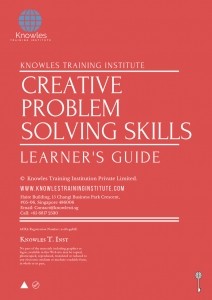
Creative Problem Solving Skills Course in Norway Handouts
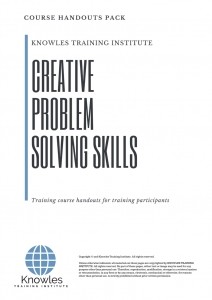
Creative Problem Solving Skills Course in Norway PPT Slides Used During Course
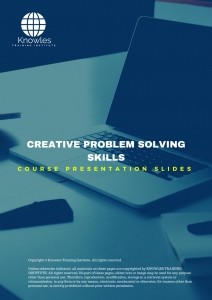
Creative Problem Solving Skills Course in Norway Certification
Each course participant will receive a certification of training completion
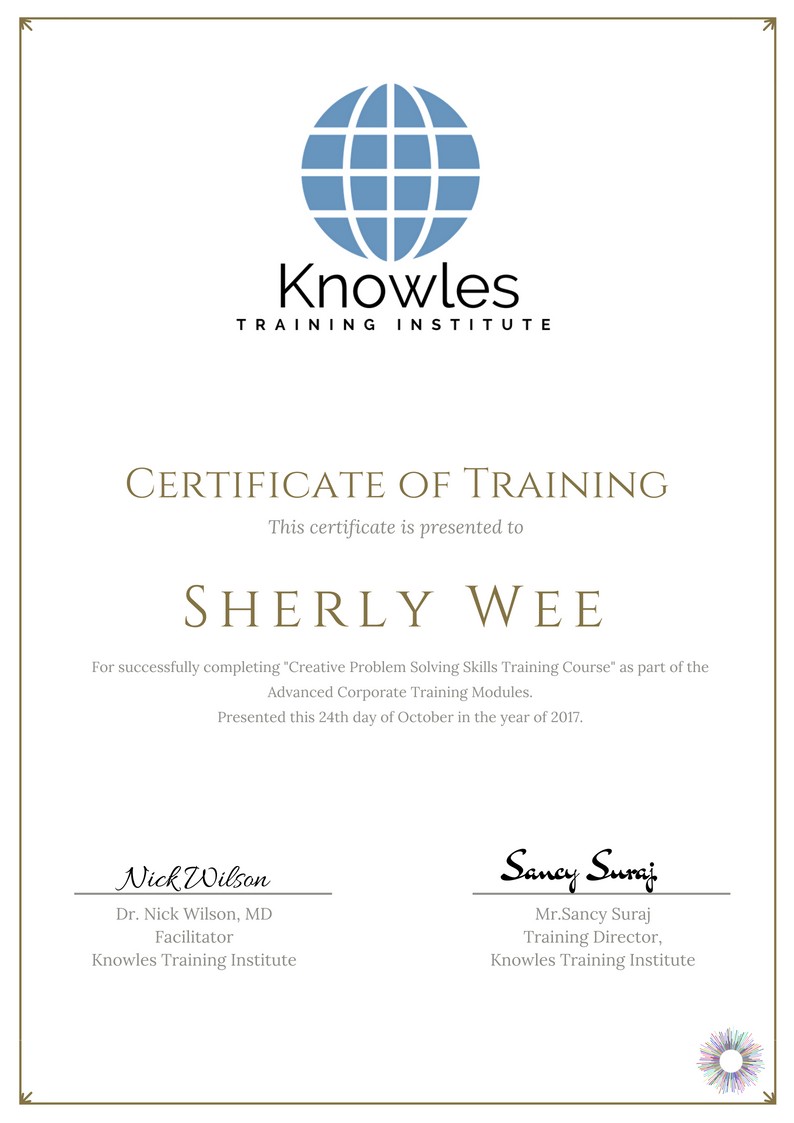
Course Fees For Creative Problem Solving Skills Training Course in Norway
There are 4 pricing options available for this Creative Problem Solving Skills training course in Norway. Course participants not in Norway may choose to sign up for our online Creative Problem Solving Skills training course in Norway.
- USD 1,019.96 For a 60-minute Lunch Talk Session.
- USD 434.96 For a Half Day Course Per Participant.
- USD 659.96 For a 1 Day Course Per Participant.
- USD 884.96 For a 2 Day Course Per Participant.
- Discounts available for more than 2 participants.
Course Discounts, Fundings & Subsidies
We have the following discounts, fundings & subsidies for this Creative Problem Solving Skills training course

Upcoming Creative Problem Solving Skills Training Course in Norway Schedule
Contact us for the latest Creative Problem Solving Skills course in Norway schedules:
Email: contact@knowlesti.co.no
Message:
Download Creative Problem Solving Skills Course in Norway Brochure
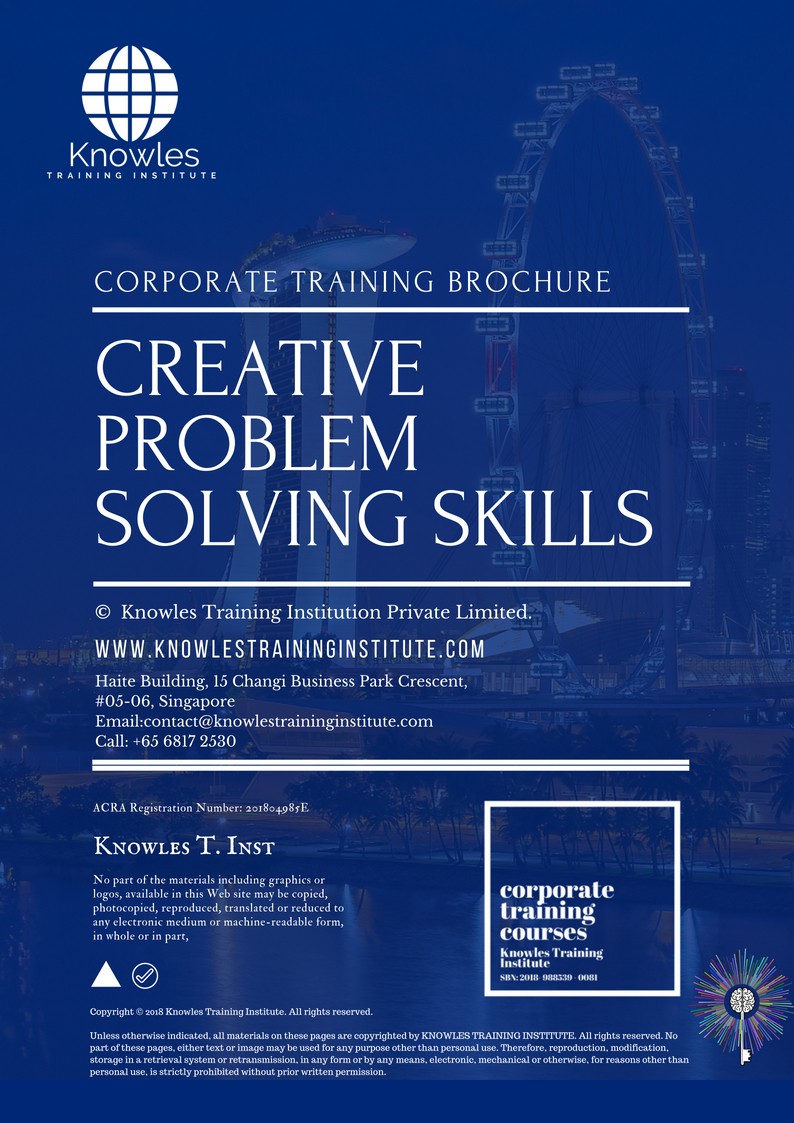
Request for this Creative Problem Solving Skills course in Norway brochure. Fill up the short information below and we will send it to you right away!
Post Training Support: A vast majority of training does not have any effect beyond 120 days. To work, training has to have a strong pre- and post-training component. Post-training reinforcement helps individuals to recall the understanding and ask questions.
Blended Learning: Learning does not occur in the classroom. Virtually everybody prefers distinct ways of learning. Successful learning should have a multi-channel, multi-modal strategy.
- We Understand The Industry: We’ve got a profound comprehension of the business, business design, challenges, strategy and the that our participants are in and have designed the courseware to cater to their professional needs.
- Course Content: Knowles Training Institute’s material is relevant, of high quality and provide specific learning results. Participants will leave the training course feeling as they have gained a strong understanding and will also be in a position to execute what they have learned sensibly.
Course Development — The workshop modules follow a systematic and logical arrangement. This structure helps to ensure that the course material allows the facilitators to deliver the course in a logical arrangement. Consider the subjects as building bricks into learning, our facilitators slowly build towards a comprehensive picture of this entire topic.
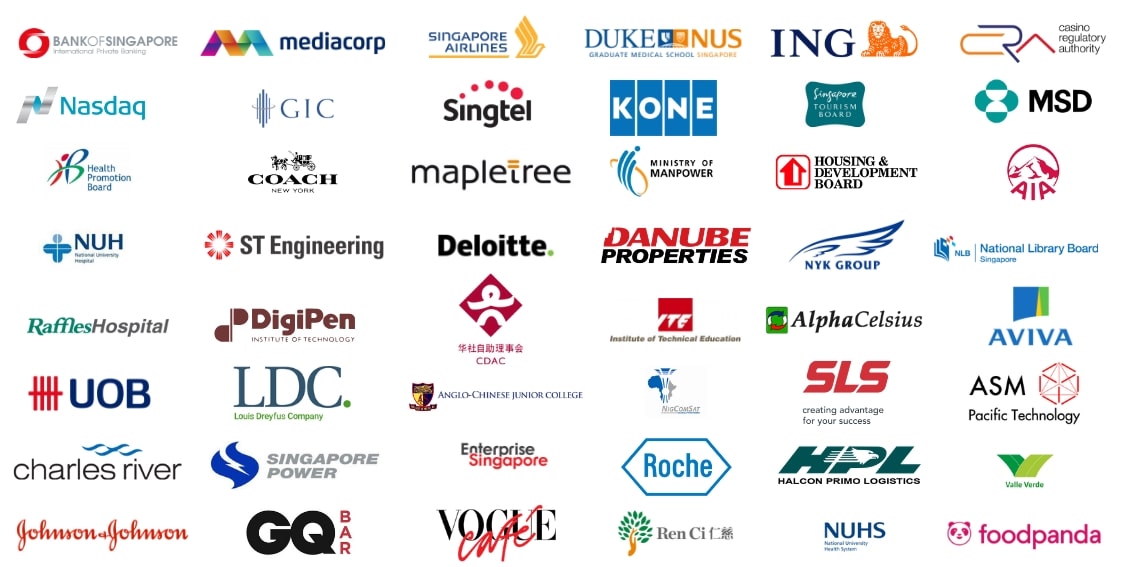
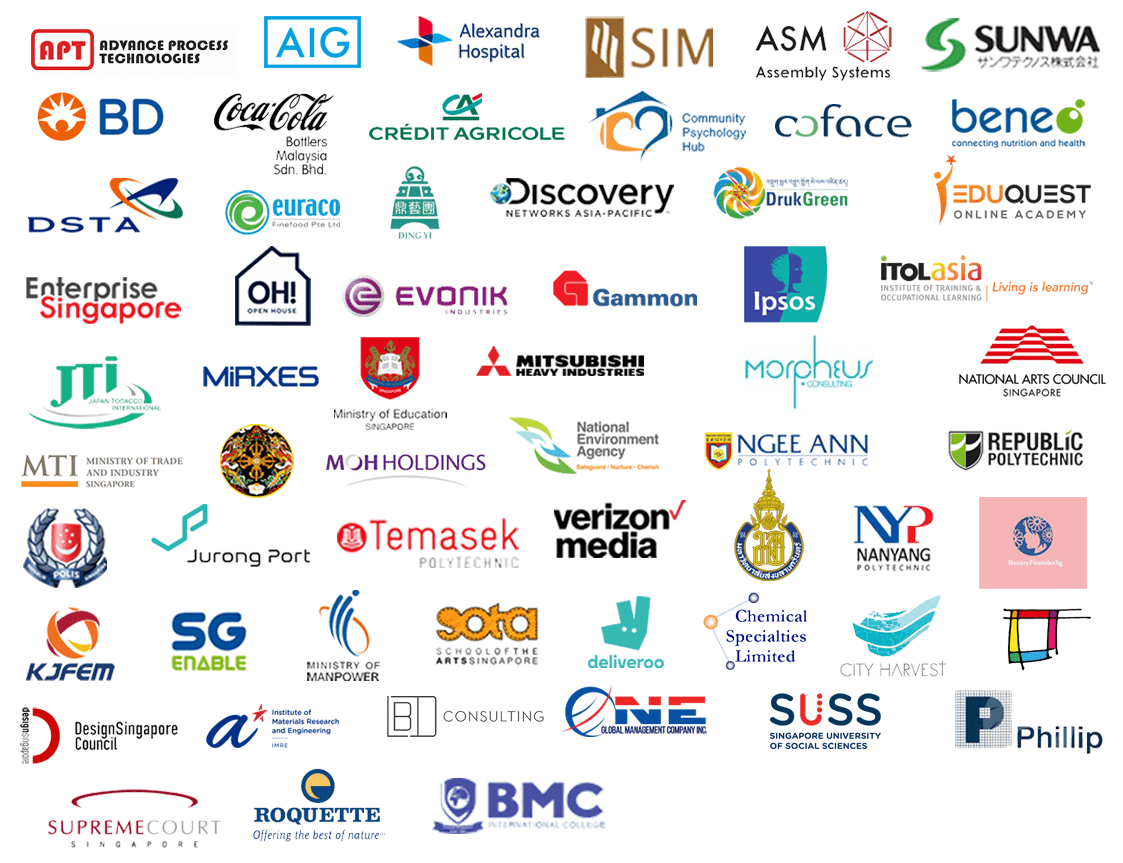
Course Enquiries

Fill up the form and we will get back to you in less than 1 working day.
Alternatively, give us a call to have one of our training consultants contact you. Our corporate training courses can be contextualized to meet your organization’s training needs. Leverage on our large pool of professional trainers and consultants for your organization’s training needs.
Email: contact@knowlesti.co.no
We Guarantee 100% Privacy. We Respect Your Privacy. Your Information Will Never Be Shared.

